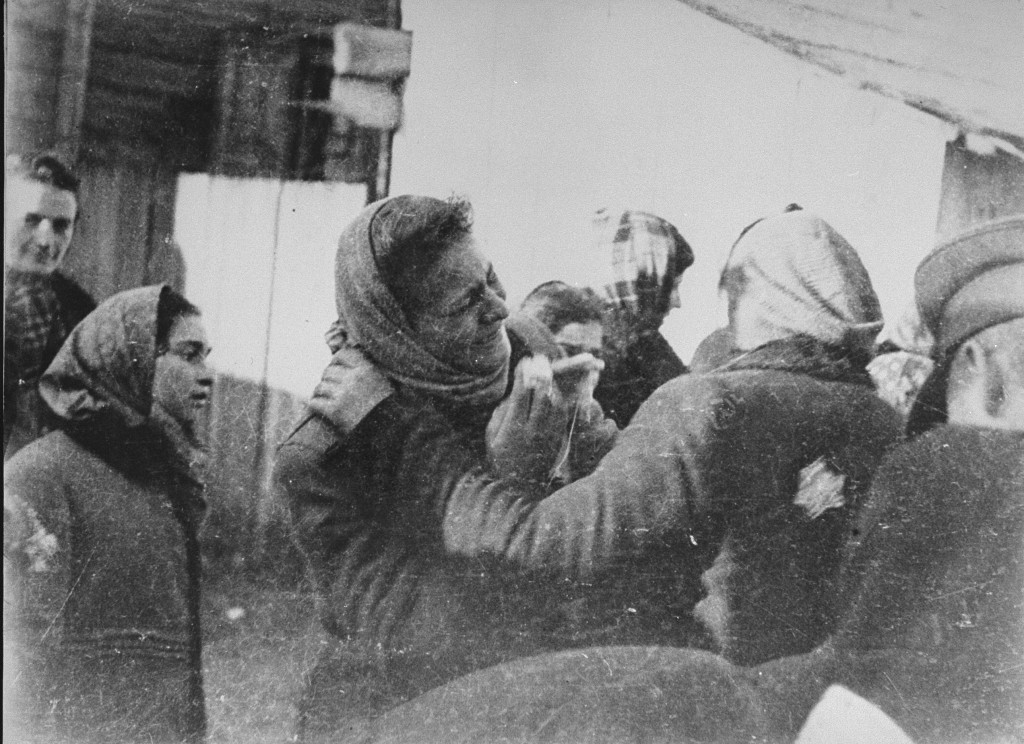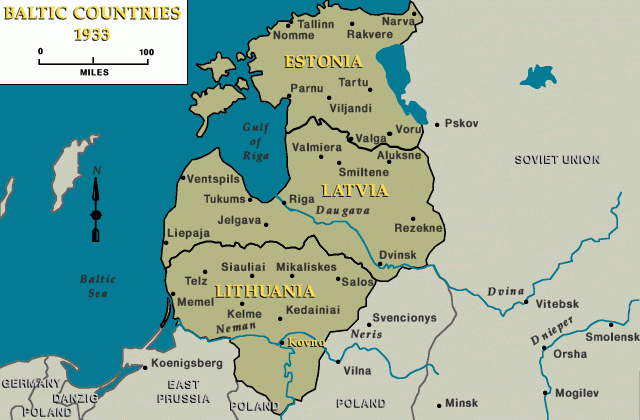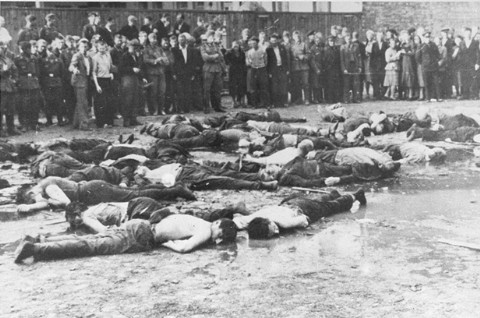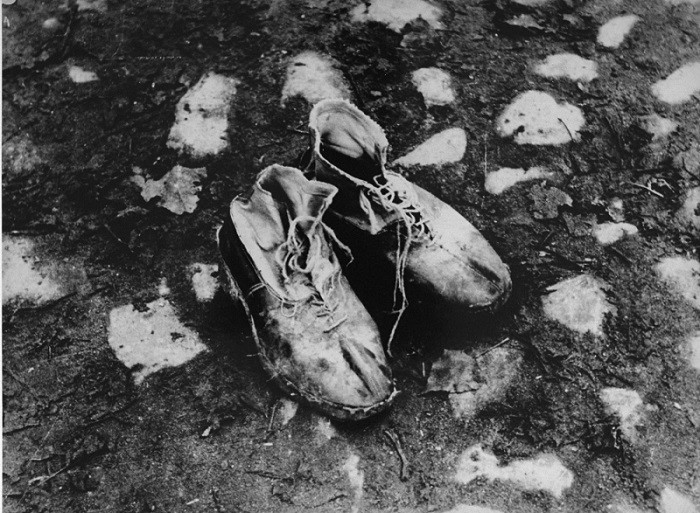
Kovno
During the Holocaust, the creation of ghettos was a key step in the Nazi process of marginalizing, persecuting, and ultimately destroying Europe's Jews. Ghettos separated Jews from the non-Jewish population and concentrated them for later deportation and mass murder. Living conditions for the imprisoned Jewish communities were appalling. One of the most well-known ghettos in the German-occupied east was the Kovno ghetto.
Kovno Before World War II
Between 1920 and 1939, Kovno (Kaunas), located in central Lithuania, was the country's capital and largest city. In 1939, it had a Jewish population of approximately 32,000. This was about one-fourth of the city's total population. Jews were concentrated in the city's commercial, artisan, and professional sectors.

Kovno was also a center of Jewish learning. The yeshiva in Slobodka, an impoverished district of the city, was one of Europe's most prestigious institutions of higher Jewish learning. Kovno had a rich and varied Jewish culture. The city had almost 100 Jewish organizations, 40 synagogues, 5 daily newspapers, a network of Yiddish and Hebrew schools, and scores of Jewish-owned businesses. It was also an important center of the Zionist movement.
Soviet Occupation
Kovno's Jewish life was disrupted when the Soviet Union occupied Lithuania in June 1940. The Soviet occupation was accompanied by arrests, confiscations, and the elimination of most cultural and religious institutions. The Soviet occupiers exiled thousands of Lithuanians to Siberia, among them many Jews. Under the Soviet occupation, Jewish communal organizations disappeared almost overnight. Soviet authorities confiscated the property of many Jews.
Meanwhile, the Lithuanian Activist Front, founded by Lithuanian nationalist emigres in Berlin, clandestinely disseminated antisemitic literature in Lithuania. Among other themes, the literature falsely blamed Jews for the Soviet occupation.
After the German Invasion of the Soviet Union

Following Germany's invasion of the Soviet Union on June 22, 1941, Soviet forces fled Kovno. Immediately before and following the German occupation of the city on June 24, anti-Communist and pro-German Lithuanian mobs began attacking Jews, whom they accused of siding with the Soviet occupiers. Violence against Jews was especially pronounced along Jurbarko and Krisciukaicio streets in the Jewish district of Kovno. At the instigation of arriving German forces, these Lithuanian nationalist, anti-Soviet underground forces murdered hundreds of Jews and took dozens more Jews to the old Lietukis garage where they were beaten to death before German and Lithuanian spectators.
In early July 1941, German Einsatzgruppen detachments and their Lithuanian auxiliaries began systematic massacres of Jews in several of the forts around Kovno. These fortifications had been constructed under the Russian Empire in the late nineteenth century for the defense of the city. Einsatzgruppen detachments and Lithuanian auxiliaries shot thousands of Jewish men, women, and children, primarily in Fort IX (also called "Ninth Fort" in English), as well as in Forts IV and VII. According to Walter Stahlecker, the leader of Einsatzgruppe A which operated in the Baltic region, in less than one week of the German occupation, 3,800 Jews had been murdered in Kaunas and a further 1,200 in the outlying areas of the city.
Ghettoization
Soon after occupying the area, German officials established a civilian administration for the local district under SA Major General Hans Kramer. Under his auspices, in July and August 1941, German occupation officials concentrated the remaining Jews, some 35,000 people, in a ghetto established in Slobodka. It was an area of small, primitive houses and no running water. The ghetto was officially sealed on August 15, 1941.
Following a model developed in German-occupied Poland, German officials established the Kovno ghetto to provide forced labor for the German military. Jews were employed primarily as forced laborers at various sites outside the ghetto, especially in the construction of a military airbase in Aleksotas. The Jewish council (Aeltestenrat or Council of Elders), headed by Dr. Elchanan Elkes, also created workshops inside the ghetto for those women, children, and elderly who could not participate in the labor brigades. Eventually, these workshops employed almost 6,500 people. The council hoped the Germans would not kill Jews who were producing for and supporting the German war effort.
In its first few months of existence, the ghetto had two parts. These parts were called the "small" and "large" ghettos, and they were separated by Paneriu Street. Each ghetto was enclosed by barbed wire and closely guarded. Both were overcrowded, with each person allocated less than ten square feet of living space. The Germans continually reduced the size of the ghetto, forcing its Jews to relocate several times.
On October 4, 1941, the Germans liquidated the small ghetto and killed almost all of its inhabitants at Fort IX. Later that same month, the Germans staged what became known as the "Great Action." Occupation officials selected close to 10,000 ghetto inhabitants they deemed "unfit" for forced labor. Half of these were children. On October 29, 1941, Einsatzgruppen units shot most of these individuals at Fort IX. The death toll on that one day was 9,200 Jews.
In the autumn of 1943, the SS assumed control of the ghetto and converted it into the Kauen concentration camp. The Jewish council's role was drastically curtailed. The Nazis dispersed more than 3,500 Jews to subcamps where strict discipline governed all aspects of daily life. On October 26, 1943, the SS deported more than 2,700 people from the main camp. The SS sent those deemed fit to work to labor camps in Estonia, and deported children and the elderly to Auschwitz. Few survived.

Documentation and Resistance
Throughout the years of hardship and horror, the Jewish community in Kovno documented its story in secret archives, diaries, drawings, and photographs. Many of these artifacts lay buried in the ground when the ghetto was destroyed. Discovered after the war, these few written remnants of a once thriving community provide evidence of the Jewish community's defiance, oppression, resistance, and death. George Kadish (Hirsh Kadushin), for example, secretly photographed the trials of daily life within the ghetto with a hidden camera through the buttonhole of his overcoat.
The Kovno ghetto had several Jewish resistance groups. The resistance acquired arms, developed secret training areas in the ghetto, and established contact with Soviet partisans in the forests around Kovno. In 1943, the General Jewish Fighting Organization (Yidishe Algemeyne Kamfs Organizatsye) was established, uniting the major resistance groups in the ghetto. Under this organization's direction, some 300 ghetto fighters escaped from the Kovno ghetto to join partisan groups. About 70 died in action. The Jewish council in Kovno actively supported the ghetto underground. Moreover, a number of the ghetto's Jewish police participated in resistance activities. The Germans executed 34 members of the Jewish police for such activities.
"Evacuation" and Liberation
On July 8, 1944, the Germans evacuated the camp, deporting most of the remaining Jews to the Dachau concentration camp in Germany or to the Stutthof camp, near Danzig, on the Baltic coast. Three weeks before the Soviet army arrived in Kovno, the Germans razed the ghetto to the ground with grenades and dynamite. As many as 2,000 people burned to death or were shot while trying to escape.
The Soviet army liberated Kovno on August 1, 1944. Of Kovno's few Jewish survivors, 500 had survived in forests or in bunkers. The Germans evacuated an additional 2,500 to concentration camps in Germany.
Critical Thinking Questions
Learn about the lives of the Jews in the community of Kovno before 1939.
How does the example of this ghetto demonstrate the complexity and the systematic nature of the German efforts to abuse and kill the Jews?
Examine the realities and choices faced by Jewish council members in the ghettos.
In what ways did Jews resist while forced to live in the ghettos?
Explore different types of primary sources. How do they further our understanding of how and why the Holocaust happened?

